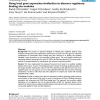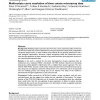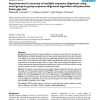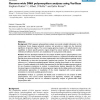BMCBI
2006
13 years 11 months ago
2006
Background: We present an approach designed to identify gene regulation patterns using sequence and expression data collected for Saccharomyces cerevisae. Our main goal is to rela...
BMCBI
2006
13 years 11 months ago
2006
Background: To infer the tree of life requires knowledge of the common characteristics of each species descended from a common ancestor as the measuring criteria and a method to c...
BMCBI
2006
13 years 11 months ago
2006
Background: Modeling of gene expression data from time course experiments often involves the use of linear models such as those obtained from principal component analysis (PCA), i...
BMCBI
2006
13 years 11 months ago
2006
Background: Pseudomonas aeruginosa, an opportunistic pathogen, is often encountered in chronic lung diseases such as cystic fibrosis or chronic obstructive pneumonia, as well as a...
BMCBI
2006
13 years 11 months ago
2006
Background: DNA microarray technology provides a powerful tool for characterizing gene expression on a genome scale. While the technology has been widely used in discovery-based m...
BMCBI
2006
13 years 11 months ago
2006
Background: Multiple sequence alignment (MSA) is a useful tool in bioinformatics. Although many MSA algorithms have been developed, there is still room for improvement in accuracy...
BMCBI
2006
13 years 11 months ago
2006
Background: The identification of differentially expressed genes (DEGs) from Affymetrix GeneChips arrays is currently done by first computing expression levels from the low-level ...
BMCBI
2006
13 years 11 months ago
2006
Background: Recent progresses in high-throughput proteomics have provided us with a first chance to characterize protein interaction networks (PINs), but also raised new challenge...
BMCBI
2006
13 years 11 months ago
2006
Background: DNA sequence polymorphisms analysis can provide valuable information on the evolutionary forces shaping nucleotide variation, and provides an insight into the function...
BMCBI
2006
13 years 11 months ago
2006
Background: More and more disordered regions have been discovered in protein sequences, and many of them are found to be functionally significant. Previous studies reveal that dis...




